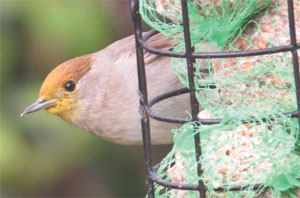| Wildlife
Newsletter for the Township of Dalkey
|
|
|
Many
people will be familiar with Blackcaps, handsome, robin sized birds
from the warbler family, the male light grey with neat black cap on
his crown while the female’s cap is light brown. Lovely singers
when they arrive as migrants in the spring but also regular winter
visitors to gardens where |
| They
brought them back to Germany where they held them till the following
autumn and when the time came for them to migrate they studied what
direction they were orientating themselves towards, which meant basically,
what direction the birds were hopping in. All the British birds orientated
themselves in a north westerly direction towards the UK while blackcaps
that had bred in southern Germany would orientate themselves in a south
westerly direction facing towards Iberia and North Africa. Professor
Stuart Bearhop concentrated his research on studying stable carbon isotopes
in the birds. This is where my friend Tom came in as, being a licensed
bird ringer, he was qualified to trap blackcaps from which he would
then take toenail and feather samples as well as very carefully extract
a tiny drop of blood from the top of their leg before releasing them
unharmed. When examined in a laboratory the stable carbon isotopes in
the samples will reveal where the birds were born as isotopes change
geographically as a result of biological and environmental processes.
The isotopes were revealing the geographical origin of the food the
birds had eaten as well as measuring the element of hydrogen in the
isotopes which varies at different latitudes. The research proved conclusively
that blackcaps wintering in Ireland were birds that had been born
in Eastern Europe. |
 A fluffed up male Yellowhammer near Broadmeadow Estuary at Swords |
|
But why did these birds start coming here in the first
place? Milder winters, gardens with lots of natural food such as berries
and also the increasing popularity of food being left out for birds
has made it much easier for them to survive our winters. But probably
the main reason is that they don’t have to migrate as far back
to their breeding ground decreasing all the risks and energy involved
in a long journey. The birds urge to migrate is triggered by day length
and, because of our higher longitude, days will be getting longer here
two weeks earlier than they would if the birds were wintering in southern
Europe so the birds wintering here will get to the best territories
earlier, using less energy on the way which can be dedicated to raising
more young who themselves will subsequently spend winter here. A few years ago BirdWatch Ireland HQ began receiving lots of phone calls and emails about strange birds with bright orange heads that had been visiting gardens around Ireland. These colourful individuals were usually seen among flocks of sparrows and starlings and in fact that’s what they were and their dramatic plumage was a result of them visiting an exotic garden plant. We are used to plants being pollinated by insects and even by the wind, but New Zealand Flax uses another method: it is pollinated by birds. The tubular flowers produce a rich, sweet nectar that many birds find irresistible. As they stick their beaks down into the flowers to feed, a small brush-like appendage dusts the tops of the birds’ heads with brightly coloured pollen, staining it a vivid orange or red colour. When they move on to feed from another flax flower, these birds bring the pollen with them, helping the plant to reproduce. Evidently this female blackcap photographed in our garden had also acquired a taste for flax nectar and the brown cap on her crown was enhanced by some bright pollen face powdering. |
DALKEY HOME PAGE | DALKEY COMMUNITY COUNCIL | DALKEY HERITAGE COMPANY | CANNONAID



